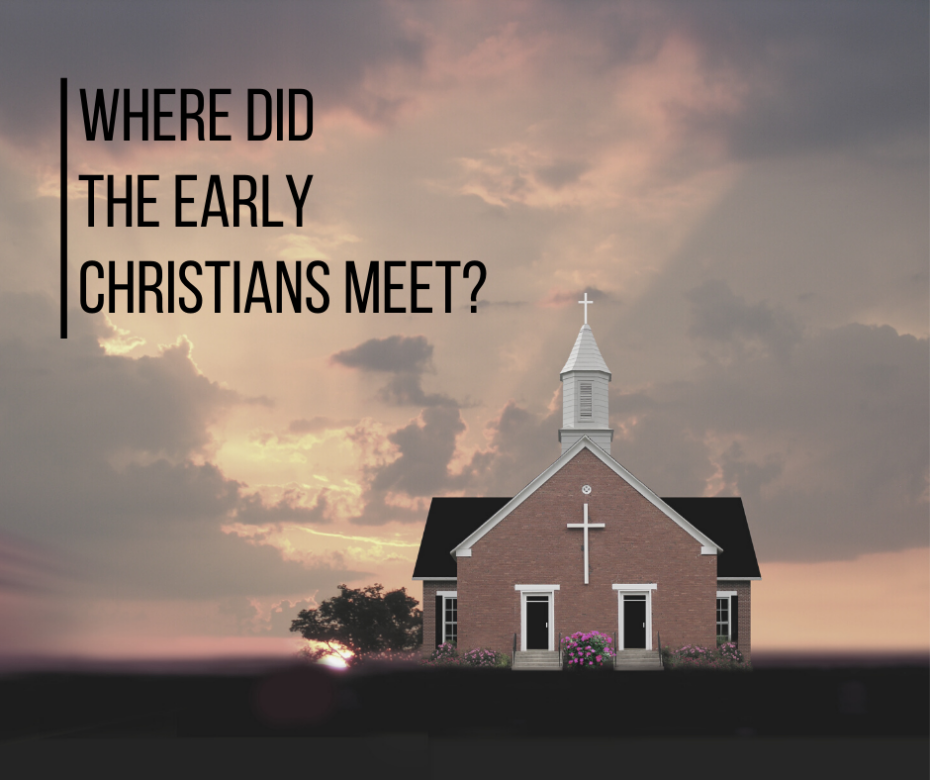Where did the early Christians meet?
Not in “church” buildings. (I put “church” in italics, because believers are the church, not the building.) The early believers were flexible. They met and ministered wherever they could.
1.They met in the Temple (until it was destroyed):
So continuing daily with one accord in the temple, and breaking bread from house to house, they ate their food with gladness and simplicity of heart (Acts 2:46a).
2. They met in rented rooms:
And He said to them, “Behold, when you have entered the city, a man will meet you carrying a pitcher of water; follow him into the house which he enters. Then you shall say to the master of the house, ‘The Teacher says to you, “Where is the guest room where I may eat the Passover with My disciples?”’ Then he will show you a large, furnished upper room; there make ready” (Luke 22:10-12).
Then they returned to Jerusalem from the mount called Olivet, which is near Jerusalem, a Sabbath day’s journey. And when they had entered, they went up into the upper room where they were staying (Acts 1:12-13a).
3. They met in homes:
…and breaking bread from house to house, they ate their food with gladness and simplicity of heart (Acts 2:46b).
Likewise greet the church that is in their house (Rom 16:5).
The churches of Asia greet you. Aquila and Priscilla greet you heartily in the Lord, with the church that is in their house (1 Cor 16:19).
to the beloved Apphia, Archippus our fellow soldier, and to the church in your house (Philemon 2).
4. And they met in schools:
But when some were hardened and did not believe, but spoke evil of the Way before the multitude, he departed from them and withdrew the disciples, reasoning daily in the school of Tyrannus (Acts 19:9).
But, so far as we know from the Biblical witness, the early Christians never met in “church” buildings. And they never seem to have built “church” buildings, either. That does not seem to have been a priority for them, even after thousands of people came to faith in Christ (Acts 2:41). (What did they do with those thousands of new converts? Where did they all meet?)
This lack of Biblical specificity about where to meet can disturb people. They want clear instruction. They want someone to tell them what to do. So, not finding it in the Bible, they put their faith in things like ancient church traditions that seem to have the answers. Not me. I want to stick to the Bible. If the Bible lacks instruction in some area, I find that liberating. It means we’re free to make the best decisions possible about where to meet.
I’m reminded of the conversation between Jesus and the woman at the well. The Samaritans had their own “church” building (i.e., the Temple on Mount Gerizim). And the Jews had their building (i.e., the Temple in Jerusalem). Who was right? Where was the real sacred space? Jesus had a surprising, Dispensational, answer:
Jesus said to her, “Woman, believe Me, the hour is coming when you will neither on this mountain, nor in Jerusalem, worship the Father. You worship what you do not know; we know what we worship, for salvation is of the Jews. But the hour is coming, and now is, when the true worshipers will worship the Father in spirit and truth; for the Father is seeking such to worship Him. God is Spirit, and those who worship Him must worship in spirit and truth” (John 4:21-24).
You’re both wrong! God is about to do something new!
The religious mindset is attracted to “sacred spaces” and other rituals. Humanly speaking, it makes some people feel closer to God. Some people feel closer to God in exquisitely ornate sacred spaces (e.g., such as in this Russian Orthodox monastery). Others feel closer to God in minimalist spaces (e.g., this Quaker meetinghouse). But whatever the preference, is that a healthy mindset? Is that how a spiritually mature person should think about where to worship?
Not in light of what Jesus said to the woman at the well.
The Lord effectively taught there are no sacred spaces anymore. We shouldn’t be looking after truly worshipful spaces, so much as “true worshipers” who gather to worship in “spirit and truth.”
No wonder the early Christians seem to have been blissfully unconcerned with “church” buildings, meeting wherever they could, whether it was the Temple, home, room, or school. But they were also free to build a building, if that would help. It’s not wrong to build a building for the worship meeting. It’s just not necessary or required to worship God. As Donald Norbie summarized it,
What did the early church do? There are no rules about buildings in Scripture. The early church was flexible and adaptable, determined to survive in every environment; therefore. Its externals were minimal, quite different from the beautiful and elaborate temple service (Norbie, The Early Church, 43).
Worship is not about the space where you meet, but the spirit in which you meet. Realtors will emphasize, “Location, location, location!” But the early Christians would have emphasized, “Spirit, spirit, spirit!”


